|
[VIEWED 407916
TIMES]
|
SAVE! for ease of future access.
|
|
|
|
|
|
JPEG

Please log in to subscribe to JPEG's postings.
Posted on 04-18-09 9:46
AM
Reply
[Subscribe]
|
Login in to Rate this Post:
1  ?
?  Liked by
Liked by
|
| |
Last edited: 11-Jun-09 09:12 AM
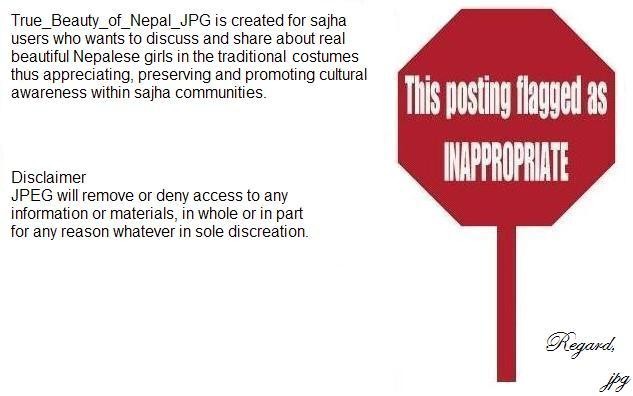
|
| |
|
|
|
|
silly_lily

Please log in to subscribe to silly_lily's postings.
Posted on 05-02-09 4:47
PM
Reply
[Subscribe]
|
Login in to Rate this Post:
0  ?
? 
|
| |
to me when one says "true beauty of nepal", it doesn't make me only think of the women although granted the beauty of the culture is portrayed on the pictures as well.
|
| |
|
|
JPEG

Please log in to subscribe to JPEG's postings.
Posted on 05-03-09 11:30
AM
Reply
[Subscribe]
|
Login in to Rate this Post:
0  ?
? 
|
| |
Chandi dance@Sakewa/Sakela by Rai nis_JPG Chandi dance is the worshiping and giving thanks to mother Goddess Uma, who came down as Chandika(Durga) to help the people get rid of evil demon Mahishasura.
Note to be taken. According to the book "DevÄ« MÄhÄtmya"("Glory of the Goddess") by Coburn, Thomas B, it is striking that the word Chandika
has virtually no earlier history in Sanskrit. "There are no instances of its occurrence in the Vedic literature we have surveyed. The epics are similarly barren: neither the Ramayana nor the Mahabharata give evidence of the epithet, although in one of the hymns inserted in the latter Canda and Candi are applied to the deity they praised." The word 'Rai' is suffixed in Boro/Borok languages in the end of most of the male offspring name, specially those who are very strong, stout and masculine. For example: Kufu-rai, Kwchak-rai, Suku-rai>Sukrai, Budu-rai, Sukundrai, Tokhi-rai, Wakhi-rai etc. Kirant Rai people worship Nature(serpeants,trees, stones, etc) and ancestors, Animism and Shamanism, believing in a their primeval ancestors Sumnima-Paruhang (Uma-Siva). Lord Siva is the greatest God of Tripuri people. He is also known as Sibrai. According to Tripuri mythology, Lord Sibrai is creator of this universe. He only created this earth, its five elements of life that is earth, water, fire, air and sky. That is why he is known as Siba meaning creator of five elements Si=Knowledge, ba=five Siva is hybrid of two Kirata words, simani means Gyan or knowledge and Kaiba, means five, i.e. Si+Ba=Siba>Siva>Sibarai>Sibrai. That means a god who has knowledge of five elements of life, that is earth, fire, water, air, and sky, that is cosmic rays which forms the life. So the word Siva is basically derived form Borok/Kirata word of Sibrai. Many historical records and mythological facts reveals that Sibrai or Siva was originally a Tripuri vis-a-vis Kirata people's original God, which later had been adopted by non-Kirata people of India, and its mythology re-written.
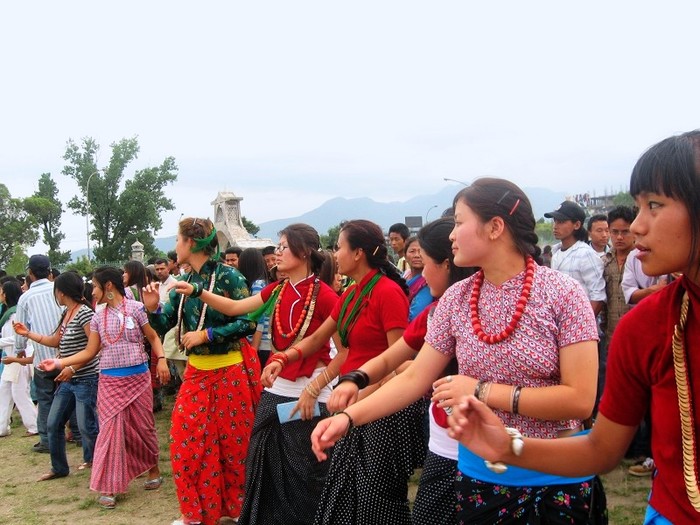
|
| |
|
|
JPEG

Please log in to subscribe to JPEG's postings.
Posted on 05-03-09 6:55
PM
Reply
[Subscribe]
|
Login in to Rate this Post:
0  ?
? 
|
| |
Magar ni beauty
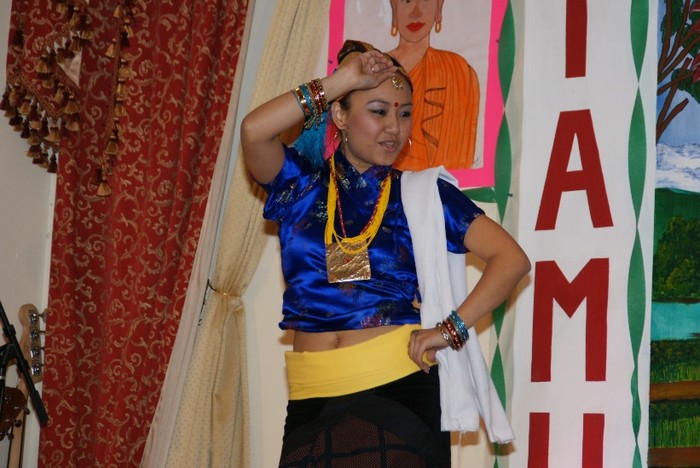
|
| |
|
|
Bhariyadai

Please log in to subscribe to Bhariyadai's postings.
Posted on 05-03-09 8:36
PM
Reply
[Subscribe]
|
Login in to Rate this Post:
0  ?
? 
|
| |
JPEG ! Super collections, and a very commendable job !
|
| |
|
|
JPEG

Please log in to subscribe to JPEG's postings.
Posted on 05-04-09 8:47
AM
Reply
[Subscribe]
|
Login in to Rate this Post:
0  ?
? 
|
| |
Tamang ni maichang
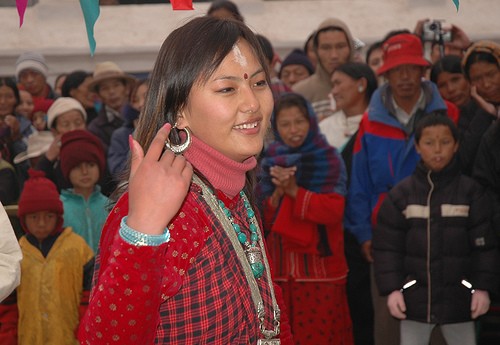
|
| |
|
|
JPEG

Please log in to subscribe to JPEG's postings.
Posted on 05-04-09 1:02
PM
Reply
[Subscribe]
|
Login in to Rate this Post:
0  ?
? 
|
| |
BeautyOfNepal_JPG by jpg

|
| |
|
|
JPEG

Please log in to subscribe to JPEG's postings.
Posted on 05-04-09 5:50
PM
Reply
[Subscribe]
|
Login in to Rate this Post:
0  ?
? 
|
| |
Pure Nepali beauty_JPG from jpg

|
| |
|
|
JPEG

Please log in to subscribe to JPEG's postings.
Posted on 05-05-09 8:41
AM
Reply
[Subscribe]
|
Login in to Rate this Post:
0  ?
? 
|
| |
Yakkha beauty JPG The indigenous Yakkha belongs to the Kirat family. Note to be taken: The Kirat Vansavali mentions that after twelve generations, one branch of Kirat people migrated from the Indo-Gangetic plains to the Himalayan region and the other branch to Lanka or Ceylon to the south. It is for this reason that some scholars admire to find one of the aboriginal tribes of Ceylon with the name of, “Yakho†similar to the Yakkha-tribe of Eastern Kirat people of Nepal.The Yakkhas, who are the aborigines of Ceylon (LankÄ), originally forest-dwelling hunters but now almost completely assimilated into the modern Sinhalese population. It is claimed that the ethnonym "Yakkha" as per the conqueror Aryan's Sanskrit grammar had been spelled in the Aryan-Hindu mythologies as "Yaksa-sh" (like Bhisu-shu for an ascetic "Bhikchu" of the Buddhist holy scripts). Although the legendary Yaksa-sh, by the corrupt name of Yakkha and Kirats are being hailed in the Hindu holy scripts Vedas and the ancient Sanskrit literature, the Yakkha is eternally firm with its own clanonym, "The Yakkha". Yaksha Kingdom refers to the territory of a tribe called Yakshas who were one among the Exotic Tribes of Ancient India. They had kinship with another similar tribe viz. Rakshasas. Yaksha king Vaisravana (also known as Kubera, Kuvera etc) and Rakshasa king Ravana were both sons of the sage Visrava Paulastya. Kubera is sometimes mentioned as a Rakshasa king. Kubera ruled a Yaksha kingdom of enormous wealth near the Kailasa mountains. Pandavas visited this place during their forest life, by mounting the Himalayas with the help of Rakshasa Ghatotkacha and his friends. The territory of Yakshas(Yakkha) under Kubera is mentioned as the region surrounding the Kailasa mountains and Manasa lake (Tibet) in the Himalayas is proven from the Mahabharata text. Expeditions of Pandavas (3:139) guided by sage Lomasa:-Lomasa said, now hast thou left behind the mountains Usiravija, Mainaka and Sweta, as well as the Kala hills, O son of Kunti, O bull among the descendants of Bharata, here flow before thee the seven Gangas. This spot is pure and holy. Here Agni blazeth forth without intermission. Now wilt thou see the play-ground of the Devas, marked with their footprints, as we have passed the mountain Kala. We shall now ascend that white rock—the mountain Mandara, inhabited by the Yakshas, Manibhadra and Kuvera, king of the Yakshas. O king, at this place eighty thousand fleet Gandharvas, and four times as many Kimpurushas and Yakshas of various shapes and forms, holding various weapons, attend upon Manibhadra, king of the Yakshas. In these regions their power is very great. And in speed they are even as the wind. They can, without doubt, displace even the lord of the Devas from his seat. Protected by them, and also watched over by the Rakshasas, these mountains have been rendered inaccessible. Here are fierce ministers of Kuvera and his Rakshasa kindred. Section 3:152 describes Pandava Bhima's expedition to this territory:-Bhima saw in the vicinity of the Kailasa cliff, that beautiful lotus lake surrounded by lovely woods, and guarded by the Rakshasas. And it sprang from the cascades contiguous to the abode of Kuvera. And situated on the rocky elevation this expanse of excellent water was exceedingly fair. That unearthly receptacle of waters was covered with celestial Saugandhika lotuses. And this lake was the sporting region of the high-souled Kuvera, the king of the Yakshas. And it was held in high regard by the Gandharvas the Apsaras and the celestials. And it was frequented by the celestial sages and the Yakshas and the Kimpurushas and the Rakshasas and the Kinnaras; Hundreds and thousands of Rakshasas, named Krodhavasas, were guarding that lake, wearing uniforms and armed with various weapons.

|
| |
|
|
JPEG

Please log in to subscribe to JPEG's postings.
Posted on 05-05-09 4:19
PM
Reply
[Subscribe]
|
Login in to Rate this Post:
0  ?
? 
|
| |
Chitko Sari makhmali choli lai beauty_JPG

|
| |
|
|
JPEG

Please log in to subscribe to JPEG's postings.
Posted on 05-05-09 8:02
PM
Reply
[Subscribe]
|
Login in to Rate this Post:
0  ?
? 
|
| |
Not enough of sareeee beauty in sari. Then here's one more!

|
| |
|
|
JPEG

Please log in to subscribe to JPEG's postings.
Posted on 05-05-09 8:12
PM
Reply
[Subscribe]
|
Login in to Rate this Post:
0  ?
? 
|
| |
10,000+ VIEWERS and rising. Thank you folks for appreciating True Beauty of Nepal. Hope you have appreciate and learn something about true beauty of Nepal, our culture and tradition. I will continue to upload the JPG of True_Beauty_of_Nepal for your sake whenever the time permit me. Love, jpg Here's BONUS from my collection...........!!

|
| |
|
|
JPEG

Please log in to subscribe to JPEG's postings.
Posted on 05-06-09 9:13
AM
Reply
[Subscribe]
|
Login in to Rate this Post:
0  ?
? 
|
| |
Nepali beauty ~“Because of your smile, you make life more beautiful.â€

|
| |
|
|
JPEG

Please log in to subscribe to JPEG's postings.
Posted on 05-06-09 8:37
PM
Reply
[Subscribe]
|
Login in to Rate this Post:
0  ?
? 
|
| |
Celebrating joy of happiness.

|
| |
|
|
JPEG

Please log in to subscribe to JPEG's postings.
Posted on 05-08-09 12:31
PM
Reply
[Subscribe]
|
Login in to Rate this Post:
0  ?
? 
|
| |
Typical Nepali beauty@discrete location! Taken by jpg

|
| |
|
|
JPEG

Please log in to subscribe to JPEG's postings.
Posted on 05-10-09 10:51
AM
Reply
[Subscribe]
|
Login in to Rate this Post:
0  ?
? 
|
| |
Lovely Rajbanshis in their beautiful costume. Rajbanshis live in the Nepal-India borderlands of the districts of Jhapa and Morang of east Nepal. Anthropologists opine that they are the kiths and kin of the peripheral Koch people of the adjacent states of West Bengal and Asom (Assam) in India. Though having Mongoloid features - they consider themselves as a branch of the Kirants - their language is akin to Bengali and Assamese. They wear clothes conforming to their climate and weather. They worship Thakur Brahmani and also practice shamanism. Consumption of alcohol is a must for worshiping the gods. They play with mud and water during their major festivals. The groom's side makes monetary payment to the bride's family during their marriage. This custom also prevails among some other ethnic groups of Nepal. Their principal occupation is agriculture. Rajbanshis were the indigenous people of Jhapa and Morang before the hill migrants of Nepal overwhelmed them. Most of the Rajbanshis bury their dead but now-a-days some of them have adopted cremation formalities. According to Census 2001, their population is 95,812. The name Rajbanshi was given after AD1515. The original tribal name of Rajbanshis is Koch or Koche. Worshippers of nature and followers of shamanistic religion these indigenous Koch people have changed their names to Rajbhanshi after coming into contact with Hindus (Sharma, BS2045; Upadhyaya, BS2051-052). They have a lifted bone over their throat a little higher than the average height. The structure of their eyes and forehead, etc is like those of a mix of Aryan-Mongloid, Austric, Negrito, Dravidian. A mix of the culture of worshippping nature and Hindu culture however seems to have developed among the Rajbanshis of Nepal.

|
| |
|
|
JPEG

Please log in to subscribe to JPEG's postings.
Posted on 05-10-09 3:26
PM
Reply
[Subscribe]
|
Login in to Rate this Post:
0  ?
? 
|
| |
Appreciate the True_Beauty_of_Nepal_JPG by jpg

|
| |
|
|
JPEG

Please log in to subscribe to JPEG's postings.
Posted on 05-10-09 7:53
PM
Reply
[Subscribe]
|
Login in to Rate this Post:
0  ?
? 
|
| |
"For every beauty there is an eye somewhere to see it"

|
| |
|
|
JPEG

Please log in to subscribe to JPEG's postings.
Posted on 05-10-09 10:59
PM
Reply
[Subscribe]
|
Login in to Rate this Post:
0  ?
? 
|
| |
Beautiful Tharu nis with wonderful smile as i took this caption.
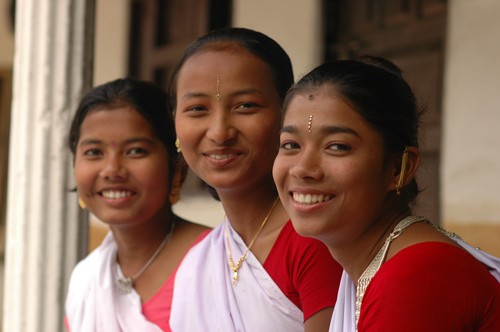
|
| |
|
|
JPEG

Please log in to subscribe to JPEG's postings.
Posted on 05-11-09 11:41
AM
Reply
[Subscribe]
|
Login in to Rate this Post:
0  ?
? 
|
| |
Limbu Nis Beauty
According to the History of Kirat People, the emergence of the name Limbu appeared after fedual war within the Kirat people. Studying closely this historical text of which was published only recently(2003) after extensive research from all side of scholars and other Kirat references that had been published before by the well known scholars, the compliation of 269 pages summarize the History of Kirat People and throws the light of reasons for being several ethnic groups in Nepal. Because the Kirati are the oldest inhabitants of Nepal and find references in
Veda, Ramayana and Mahabharata text, many scholars have studied the term Kirat and found that their root goes back even further as far as the history of the Ashur people and originating from Babylon makes it even more interesting and signifcant.
According to this source, Emergence of the name “Limbuwan†and Limbu for people emerged after THE THIRD REVOLUTION OF THE KIRATI PEOPLE.
"After the final resolution for the revolution, the leaders of Shan Monkwan people challenged their rulers in the battle field. The eight Kirat chiefs raised their troops and ordered them to massacre all the people of the villages occupied by the children of Shan Mokwan people and annihilate them. Thus, they declared war with the Shan Mokwan people of their own land. A great war broke out and the Shan Mokwan people also fought very bravely. In every village, the Shan Mokwan people gained victory over their kings and drove them away from their lands. Some of the kings were slain in the battle and some left their native place and fled away to other countries. The Shan Mokwan people then seized the country as their own. After their victory, then assembled at their holy place, consulted and fixed the boundaries of the conquered land. They fixed the northern boundary in Tibet; the southern boundary in the Indian plain at Jalal Garh near Purnea; the eastern boundary at river Teesta and the western boundary at river Dudkoshi. They further held a meeting at the holy place of Ambe pojoma, discussed, consulted
and decided to name the Kirat land by the name of, “Limbuwan.â€
The word Limbu roughly means or translates as an archer or 'the bearer of bows and arrows'. They call themselves Yakthumba/Yakthung (in Limbu language). They are also known as Shong, Xong or Drenjongka (in Tibet) or Chong, Tsong in (Sikkim).Limbu Clans and Tribes are divided into the Lhasa gotra (those from Lhasa,Tibet) and Yunan gotra (those who come from Yunan China). Before the unification of Limbuwan with Gorkha, the Term Limbu did not stand as Jaat or Varna of Hindu system, but Limbu meant anyone living in the Limbuwan's domain. After the Unification of Limbuwan and Gorkha, the Gorkhali King and Khas-Brahmin immigrants classified all those living in Limbuwan as Limbus and ranked them as one of the "Namasine Matwali Jaat".
Points to be taken: The term "Subba" is not a clan name of a Limbu nationality, Subba is a title given by the Shah Kings to Limbu village chiefs.

|
| |
|
|
JPEG

Please log in to subscribe to JPEG's postings.
Posted on 05-11-09 7:22
PM
Reply
[Subscribe]
|
Login in to Rate this Post:
0  ?
? 
|
| |
The Number is 6. Newar Nis Beauty

|
| |
